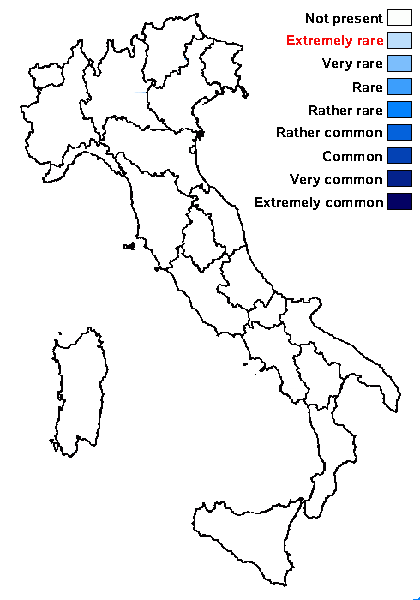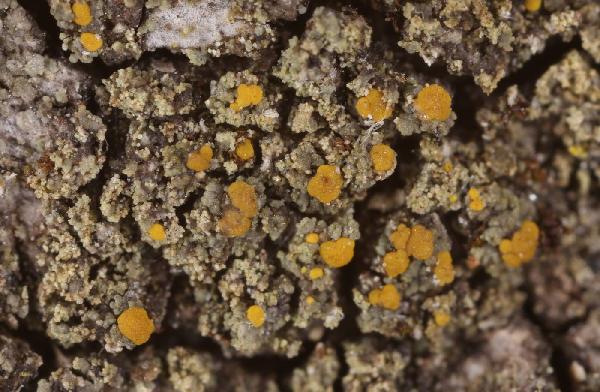Protocandelariella blastidiata (Yakovch.) D. Liu, Hur & S.Y. Kondr.
in Kondratyuk & al., Acta Bot. Hung. 62, 3-4: 305, 2020. Basionym: Candelariella blastidiata Yakovch. - in Yakovchenko & al., Lichenologist, 49: 120, 2017.
Synonyms:
Distribution:
Description: Thallus subcrustose to usually minutely squamulose, pale grey to pale brownish grey, matt, the squamules soon ascending to erect, scattered to somewhat imbricate, (0.2-)0.3-0.5(-0.7) mm long, (75-)103-141(-163) μm thick, with irregularly incised margins, the lower surface blastidiate and rarely also with a layer of conidiophores at the base of the squamules. Blastidia (25-)27-41(-60) μm wide, at first marginal, then spreading especially on the lower surface. Pseudocortex up to 25 μm thick, consisting of gelatinized hyphae with more or less isodiametrical cells. Apothecia biatorine, yellow, (0.3-)0.4-0.5(-0.9) mm across, with an initially rounded and weakly convex, finally irregular and strongly convex disc, the proper margin hidden below the convex disc. Proper exciple of branched and anastomosing hyphae radiating towards the margin, with more or less rectangular cells; epithecium yellow-brown; hymenium colourless, 45-63 μm high; paraphyses simple to branched, in 1.5-2.5 μm thick at mid-level, the apical cells up to 3 μm wide; hypothecium colourless, with oil droplets. Asci 8-spored, clavate to broadly clavate, with an apical dome which is I+ blue only in the internal, lower part, interrupted in the centre by a I+ paler blue strip, Candelaria-type. Ascospores 1-celled to indistinctly septate, hyaline, narrowly ellipsoid, straight to slightly curved, (7.5-)10-14.5(-15) x (3.5-)4-5 μm. Pycnidia not known, the cylindrical to flask-shaped conidiogenous cells rarely developing on the lower surface of squamules. Conidia subglobose to widely tear- or drop-shaped, (2.5-)4.0-6.5(-7.5) μm wide. Photobiont chlorococcoid. Spot tests: thallus K-, C-, KC-, P-; apothecia K- or K+ weakly orange. Chemistry: thallus without lichen substances; apothecia with calycin, pulvinic acid, and pulvic dilactone.Note: a recently-described epiphytic species growing on deciduous trees, hitherto known from a few localities in Eurasia and Western North America, including Central Europe. To be looked for in Italy.
Growth form: Crustose
Substrata: bark
Photobiont: green algae other than Trentepohlia
Reproductive strategy: mainly asexual, by soredia, or soredia-like structures (e.g. blastidia)

Predictive model
Growth form: Crustose
Substrata: bark
Photobiont: green algae other than Trentepohlia
Reproductive strategy: mainly asexual, by soredia, or soredia-like structures (e.g. blastidia)

Predictive model


